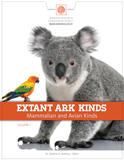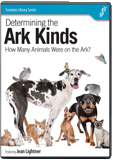
Hoatzin Bird: Evidence Against Evolutionary Ideas
Evolutionists love to talk about how dinosaurs evolved into birds. Their favorite example is undoubtedly Archaeopteryx, which they believe is either one of, or the first transitional forms between dinosaurs and birds.1 In making this argument, they point to Archaeopteryx’s combination of feathers, wings, and claws on the wing, among other traits, which they claim are indicative of a creature evolving from a reptile into a bird. Yet there is a living bird which displays all of these features, at least as a chick and fledgling. That bird is the South American rainforest denizen, the hoatzin. The hoatzin provides evidence that Archaeopteryx is not a transitional form after all.
The hoatzin is a very unique bird, something of a conglomeration of traits typical of birds, reptiles, and even mammals. As a bird, it shares characteristics typical of birds such as being warm-blooded, having feathers, and so on. It is roughly the size of a turkey, with a colorful, crested head and long tail feathers. However, its most interesting and unique features are distinctly un-birdlike.
Hoatzin History
A few fossils of the hoatzin have been found. According to the evolutionary paradigm, hoatzins originated in Africa. Fossils have been found as far afield as Kenya and Namibia. However, these are incredibly fragmentary finds, consisting only of a shoulder and wing bone (coracoid and humerus respectively) from Namibia, and a coracoid and tarsometatarsus (foot) bone from Kenya.2 Further fossils have been discovered in France, Brazil, and Colombia, but none of these fossils are the complete bird, but generally comprising just one or two bones.3 Nevertheless, evolutionists are insistent that the hoatzin evolved in Africa, based on less than a dozen bones and not one complete skeleton.
While the evidence for an African origin of hoatzins is slim, tracking down their purported evolutionary ancestry has proved even more problematic. Before any determination was made, scientists recognized that hoatzins were an issue for evolutionary cladistics, i.e., the study of how all organisms are supposedly “related.”4 About a year after that acknowledgement was published, a new study came out that attempted to relate the hoatzins to cuckoos using mitochondrial DNA (mtDNA).5 While the hoatzin does share some physical characteristics with cuckoos, this study did not end the debate within the scientific community. Another study, published a few years later, used different mtDNA sequences and argued that hoatzins did not descend from cuckoos at all. “Instead, our analyses indicate that the hoatzin is most closely related to the turacos (Musophagiformes: Musophagidae), a small family of arboreal, frugivorous birds inhabiting sub-Saharan Africa.”6 Still this did not solve the problem for the scientific community.
A few years later, another study came out which was heavily critical of the turaco study and postulated that hoatzins were not related to cuckoos or turacos. Instead, this study posited a weak connection to doves!7 However, this, as deliberately vague as it was, did not bring a close to what is repeatedly referred to as the “hoatzin problem”8 and “enigmatic.”9 A comprehensive phylogenetic study of birds with nearly twenty expert authors, published in Science a few years after the dove article was published, made no effort even to attempt to explain the hoatzin. “The enigmatic Opisthocomus (hoatzin) still cannot be confidently placed, but some putative sister relationships can be rejected.”10 The hoatzins unique traits and obvious discontinuity from other birds have completely impeded any evolutionary attempt to classify it. Evolutionary scientists have no explanation for the origin of the hoatzin, despite numerous attempts to create a phylogenetic tree that will fit them.
It’s almost as if God designed this creature specifically to confound evolutionary dogma.
The word used most often by scientific journals to describe the hoatzin is the word “enigma.” Enigma means “something hard to understand or explain” and the repeated use of the term is very indicative of the struggles evolutionists have with hoatzin.11 Why is it that the brightest evolutionary scientists are left mystified by this pheasant-sized bird? It’s almost as if God designed this creature specifically to confound evolutionary dogma.
Designed to Do What It Does Do
Hoatzins have an unusual reproductive system and exhibit specialized nesting and parental behavior. The hoatzin builds its nest overhanging water. The eggs are incubated for around a month before hatching. After hatching, adults, and sometimes other members of the social group, feed the chicks for two months.12 Reproductive success is quite low, with some researchers finding a mere twenty-seven percent of eggs making it to hatching.13 However, when larger social units help care for the nests, as is often the case in hoatzins, reproductive success improves, and fledging happens more quickly.14
When the young hoatzins hatch, they have claws on their wings. This has been known for over one hundred years.15 When frightened, the young hoatzin will abandon the nest and dive into the water to either hide or dive for safety. Once the threat is gone, the fledgling will use its claws to grasp low-hanging branches. It then takes a firm hold and pulls itself out of the water using its feet, much like a child climbing out of a pool, with the claws functioning to help keep its grip.16 The claws are present and functional for at least the first 100 days of the fledgling hoatzin’s life, but they are not present in adult hoatzins.
These claws have been a puzzle for evolution theory, with some proposing a link to Archaeopteryx, though most others reject this and argue for a later adaptation.17 The Audubon Society’s article on the hoatzin argues that these claws were developed because of the need to get back into the nest after diving for cover.18 This claim has two significant issues: The first comes from potential mortality rate. If the hoatzin chick dove for cover into the water and did not have these specialized wing claws, it would struggle to make it back to the nest and likely would die. Dead chicks do not evolve. Necessity does not introduce new information into the genome.
The second issue with the Audubon Society’s idea comes from leading evolutionists themselves. Sir Francis Crick, co-discoverer of the DNA double helix, wrote, “I suspect that some people also dislike the idea that natural selection has no foresight. The process itself, in effect, does not know where to go. It is the ‘environment’ that provides the direction, and over the long run its effects are largely unpredictable in detail.”19 Richard Dawkins, probably the closest thing evolutionists have to a high priest, went even further: “Natural selection, the blind, unconscious, automatic process which Darwin discovered,20 and which we now know is the explanation for the existence and apparently purposeful form of all life, has no purpose in mind. It has no mind and no mind's eye. It does not plan for the future. It has no vision, no foresight, no sight at all.”21 Clearly, evolutionists view natural selection as unguided and heedless of the future. Yet the hoatzin chick needs to have the claws in place when they hatch in order to perform their evasive behavior, implying forethought—a possibility leading evolutionists exclude entirely.
Furthermore, even as adults, hoatzins still leave many scientists mystified. Unlike most other birds, hoatzins are strictly vegetarian, eating leaves from trees and bushes rather than insects or small animals. Hoatzins are clearly designed for this diet. Their head is small and mobile compared to the rest of their body, enabling them to maneuver between branches while grabbing leaves to eat.22 Even more incredibly, hoatzins have a stomach that more closely resembles that of a cow than any known bird!23 They exhibit a process called foregut fermentation. This refers to the food they eat fermenting in the crop and esophagus of the birds, before it ever reaches their stomach,24 accelerating the difficult process of breaking down fibrous plant material. This requires the crop and esophagus to be much larger than they are in birds of similar sizes, which leaves a reduced space for the flight muscles, reducing also the bird’s ability to fly.25 However, since most of the plants they eat are somewhat low in nutritional value, thus producing less energy for the bird, this is not an issue because they need less energy than other birds that fly more frequently.26
To ferment the food in the foregut, the birds have microbial colonies living in their esophagus and crop. These bacteria enable it to digest cellulose, a major component of plant material that is indigestible to most vertebrates naturally.27 This empowers hoatzins to derive more nutrients from each meal, meaning they do not need to eat as many plants as other birds would to get the same amount of nutrients. This fact is crucial since weight must be minimized for optimum flight. As stated before, this digestive system strongly resembles ruminants in form and function. Perhaps evolutionists should consider classing the hoatzin as a ruminant since all other classification attempts have failed?
False Dichotomy?
The hoatzin provides a strong challenge for evolutionary dogma in multiple ways. No evolutionist regards hoatzin as being a link between birds and reptiles. Yet one of the key features of Archaeopteryx, which is considered to be a transitional form, is also found in hoatzins. So are hoatzins a living transitional form, or is Archaeopteryx an extinct bird? In his doctoral thesis on the hoatzin, Dr. Antje Mullner, an evolutionist, rejected hoatzin as a transitional form. “Many tourist guides in the Neotropics still present the hoatzin as a living fossil. However, wing claws are in fact known in a variety of bird species, e.g., in some Turacos. It is most likely that the wing claws are a secondary adaptation closely linked with the aquatic environment of the species . . . .”28 This interpretation leaves Archaeopteryx as an extinct bird since the missing link possibility is ruled out.
So are hoatzins a living transitional form, or is Archaeopteryx an extinct bird?
Even ignoring the devastating blow hoatzin deals to Archaeopteryx as a transitional form, it causes evolutionists other significant problems, as evidenced by the trouble it gives to their cladistic models. They simply cannot determine what its ancestor was. However, if they would pause long enough to consider Genesis 1, they might recognize that hoatzin likely is its own created kind and thus its ancestor was a hoatzin.29 This also would explain the unique hoatzin digestive system, found in no other birds.30 Of course, that would require evolutionists to admit that there is a God, and since many refuse to even acknowledge a designer, this is unlikely. Sir Francis Crick summed up the attitude of the general science population towards any possibility of design. “Biologists must constantly keep in mind that what they see was not designed, but rather evolved.”31 In other words, evidence of design does not matter, scientists must embrace evolution, in spite of the evidence. Sadly, the hoatzin has not caused evolutionists to doubt their worldview, or even consider the possibility that hoatzin was made by God to do exactly what it does today.
Answers in Depth
2019 Volume 14
Answers in Depth explores the biblical worldview in addressing modern scientific research, history, current events, popular media, theology, and much more.
Browse VolumeFootnotes
- Martin Kundrat et al. “The First specimen of Archaeopteryx from the Upper Jurassic Mornsheim Formation of Germany,” Historical Biology 31, no. 1 (2019): 3–63, doi:10.1080/08912963.2018.1518443.
- Gerald Mayr, “A Hoatzin Fossil from the Middle Miocene of Kenya Documents the Past Occurrence of Modern-Type Ospisthocomiformes in Africa,” The Auk 131, no 1. (2014): 55–60, doi:10.1642/AUK-13-134.1.
- Gerald Mayr and Vanessa L. De Pietri, “Earliest and First Northern Hemisphere Hoatzin Fossils Substantiate Old World Origin of a “Neotropic Endemic,” Naturwissenschaften 101 (2014): 143–148, https://www.researchgate.net/
profile/ Vanesa_De_Pietri/ publication/ 259807811_ Earliest_ and_ first_ Northern_ Hemispheric_ hoatzin_ fossils_ substantiate_ Old_World_ origin_of_a_ Neotropic_ endemic/ links/ 5463f8280cf2837efdb34833.pdf. - John C. Avise, William S. Nelson, and Charles G. Sibley, “Why One-Kilobase Sequences from Mitochondrial DNA Fail to Solve the Hoatzin Phylogenetic Enigma,” Molecular Phylogenetics and Evolution 3, no. 2 (June 1994): 175–184, https://faculty.sites.uci.edu/johncavise/files/2011/03/142-hoatzin.pdf.
- S. Blair Hedges et al., “Phylogenetic Relationships of the Hoatzin, an Enigmatic South American Bird,” The Proceedings of the National Academy of Sciences 92 (1995): 11662–11665, https://www.pnas.org/content/pnas/92/25/11662.full.pdf.
- Janice M. Hughes and Allan J. Baker, “Phylogenetic Relationships of the Enigmatic Hoatzin (Opisthocomus hoazin) Resolved using Mitochondrial and Nuclear Gene Sequences,” Molecular Biology and Evolution 16, no. 9 (1999): 1300–1307, https://academic.oup.com/mbe/article/16/9/1300/2925617 .
- Michael D. Sorenson et al., “More Taxa, More Characters: The Hoatzin Problem Is Still Unresolved,” Molecular Biology and Evolution 20, no. 9 (2003): 1484–1498, doi:10.1093/molbev/msg157.
- Ibid.
- Hedges et al., “Phylogenetic Relationships;” Hughes and Baker, “Phylogenetic Relationships;” Sorenson et al., “More Taxa, More Characters;” and Avise et al., “Why One-Kilobase Sequences.”
- Shannon J. Hackett et al., “A Phylogenomic Study of Birds Reveals Their Evolutionary History,” Science 320 (2008): 1763–1768, doi:10.1126/science.1157704.
- Merriam-Webster’s Collegiate Dictionary, 11th ed. (Springfield: Meriam Webster Incorporated, 2003), 414.
- Antje Mullner, “Breeding Ecology and Related Life-History Traits of the Hoatzin, Opisthocomus hoazin, in a Primary Rainforest Habitat.” (PhD diss., University of Wurzburg, 2004), https://opus.bibliothek.uni-wuerzburg.de/opus4-wuerzburg/frontdoor/deliver/index/docId/1127/file/Dissertation_Muellner.pdf#page=123.
- M. G. Dominguez-Bello et al., “Ecology of the Folivorous Hoatzin (Opisthocomus hoazin) on the Venezuelan Plains.” The Auk 111, no. 3 (1994): 643–651, https://www.jstor.org/stable/4088467.
- Eric A. VanderWerf and Stuart D. Strahl, “Effects of Unit Size and Territory Defense on Communal Nest Care in the Hoatzin (Opisthocomus hoazin).” The Auk 107, no. 3 (1990): 626–628, https://www.jstor.org/stable/4087935.
- Dominguez-Bello et al., “Ecology of the Folivorous Hoatzin.”
- Stuart D. Strahl, “The Social Organization and Behavior of the Hoatzin Opisthocomus hoazin in Central Venezuela,” IBIS 130 (1987): 483–502, doi:10.1111/j.1474-919X.1988.tb02714.x.
- Mullner, “Breeding Ecology.”
- Elizabeth Deatrick, “The Hoatzin: Misfit, Belcher, Genetic Mystery,” Audubon Society, accessed October 31, 2018, https://www.audubon.org/news/hoatzin.
- Francis Crick, What Mad Pursuit (New York: Basic Books, 1988), 28.
- Dawkins is being disingenuous in making this claim, since creationist Edward Blyth proposed the natural selection idea before Darwin wrote his book and gave the concept its title. See Georgia Purdom, “Is Natural Selection the Same Thing as Evolution?,” in The New Answers Book 1, ed. Ken Ham (Green Forest, AR: Master Books, 2006), https://answersingenesis.org/natural-selection/is-natural-selection-the-same-thing-as-evolution/.
- Richard Dawkins The Blind Watchmaker (New York: W. W. Norton & Company, Inc., 1996), 6.
- Leonid P. Korzun et al., “Biomechanical Features of the Bill and Jaw Apparatus of Cuckoos, Turacos and the Hoatzin in Relation to Food Acquisition and Processing,” Ostrich 74, no. 1–2 (2003): doi:10.2989/00306520309485369.
- André-Denis G Wright, Korinne S. Northwood, and Nestor E. Obispo. “Rumen-Like Methanogens Identified from the Crop of the Folivorous South American Bird, the Hoatzin (Opisthocomus hoazin),” International Society for Microbial Ecology Journal 3 (2009): 1120–1126, doi:10.1038/ismej.2009.41.
- Alejandro Grajal et al., “Foregut Fermentation in the Hoatzin, a Neotropical Leaf-Eating Bird,” Science 245, no. 4923 (1989): 1236–1238, doi:10.1126/science.245.4923.1236.
- Wright et al., “Rumen-Like Methanogens.”
- Alejandro Grajal, “ Structure and Function of the Digestive Tract of the Hoatzin (Opisthocomus hoazin): A Folivorous Bird with Foregut Fermentation.” The Auk 112, no. 1 (1995): 20–28, doi:10.2307/4088763.
- Mullner, “Breeding Ecology.”
- Ibid.
- Jean Lightner, “An Initial Estimate of Avian Ark Kinds,” Answers Research Journal 6 (2013): https://answersingenesis.org/creation-science/baraminology/an-initial-estimate-of-avian-ark-kinds/.
- Wright et al., “Rumen-Like Methanogens.”
- Crick, What Mad Pursuit, 138.
Recommended Resources

Answers in Genesis is an apologetics ministry, dedicated to helping Christians defend their faith and proclaim the good news of Jesus Christ.
- Customer Service 800.778.3390
- © 2024 Answers in Genesis



